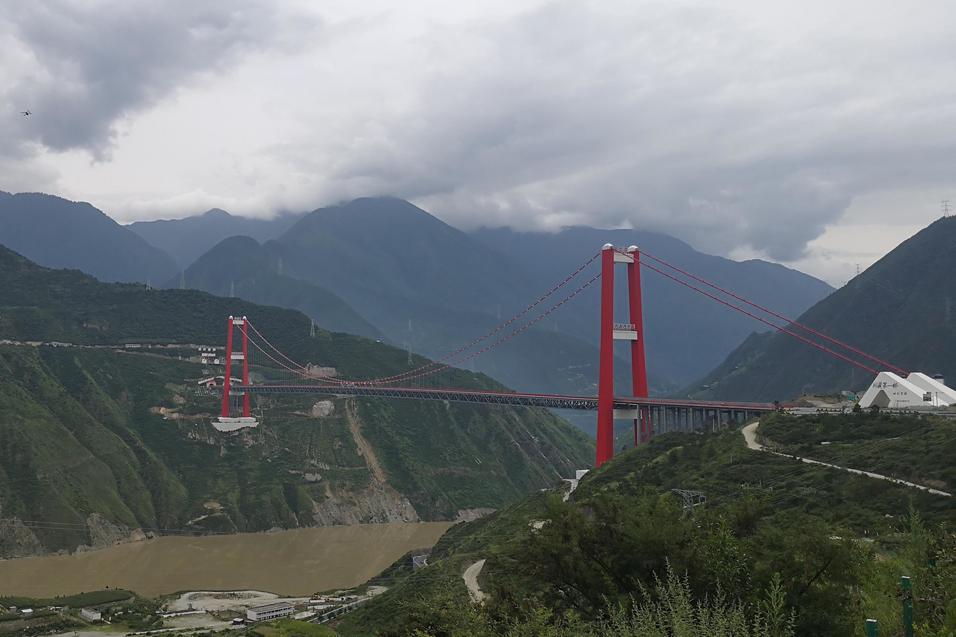 The bridge of the Ya'an-Kangding Expressway over the Dadu River in Luding county in the Garze Tibetan autonomous prefecture, Southwest China's Sichuan province. (PHOTO PROVIDED TO CHINA DAILY)
The bridge of the Ya'an-Kangding Expressway over the Dadu River in Luding county in the Garze Tibetan autonomous prefecture, Southwest China's Sichuan province. (PHOTO PROVIDED TO CHINA DAILY)
Soon after the national college entrance examination ended on June 8, Hao Jun, an 18-year-old from Chengdu, Sichuan province, decided to book a bus ticket for Luding county in the province's Garze Tibetan autonomous prefecture.
He wanted to refresh himself after years of preparation for the exam. Luding is far from the madding crowd in Chengdu and features the famous Luding Bridge and his favorite red cherries.
His parents readily accepted his plan, as Luding is only a two-and-a-half-to three-hour bus ride away.
"Before the opening of the Ya'an-Kangding Expressway, it took five to six hours to reach Luding from Chengdu," his mother, Ying Liu, said. "And I would not have approved it if he'd had the plan then."
The 135-kilometer Ya'an-Kangding Expressway, which is part of a new Sichuan-Tibet highway that will extend from Chengdu to Lhasa in Tibet, opened in 2018.
Before the opening of the Ya'an-Kangding Expressway, it took five to six hours to reach Luding from Chengdu.
Ying Liu, mother of a high school graduate in Chengdu
Since then, mountainous Luding has witnessed a surge in tourist numbers. Tourists come to cross Luding Bridge, dine in rural resorts and simply escape the city crowds, according to Lu Chukai, an information officer with the Luding county committee of the Communist Party of China.
The bridge over the Dadu River provided a crossing point in history that every Chinese pupil has learned about.
The Red Army's seizure of the bridge on May 29, 1935, was a famous incident in a story filled with heroes. The bridge's planks had been removed by Kuomintang troops on the river's east bank to cut off the troops of the Red Army, a predecessor of the People's Liberation Army, leaving just 13 iron chains in place.
ALSO READ: Red Army history reflects success through hardship
Despite that, Red Army soldiers crossed the bridge, suffering only a few deaths among their 22-strong force.
The Red Army's crossing of the Dadu River was one of the most important events of the Long March (1934-36), because if it had failed, the Red Army might have been wiped out.
In the first five months of this year, 891,700 people visited Luding, more than two and a half times as many as in the same period last year. Tourism earnings surpassed 980 million yuan (US$153 million), Lu said.
Since March, the number of tourists visiting Luding Bridge has been rising, with 1,000 to 2,000 people arriving every day.
The surge in tourist numbers has a lot to do with the opening of the Ya'an-Kangding Expressway and the 100th anniversary of the founding of the CPC on July 1, because the bridge is a reminder of an important moment in history, said Li Yuanjiao, an administrator in charge of the bridge.
For safety reasons, only 80 to 100 people are allowed to stand on the structure at the same time, he said.
All 31 star-rated rural hotels and resorts in Luding are full on weekends as visitors can pick red cherries from trees and eat them for free to their hearts' content.
READ MORE: Long march tourism boosts heritage protection
At this time of year, visitors come to eat cherries, as well as dishes made from chicken, bacon, beans and edible wild herbs, said Guo Yurong, the middle-aged owner of a rural resort.
As it is the harvest season for red cherries, farmers can be seen in the streets of the county seat selling the fruit from bamboo baskets, with a kilogram costing about 20 yuan.
Song Xiaojun, Party secretary of Luding, said that development of tourism triggered by improved roads contributed to Luding becoming the first place in the prefecture to be removed from a national list of poverty-stricken counties.
Contact the writer at huangzhiling@chinadaily.com.cn


